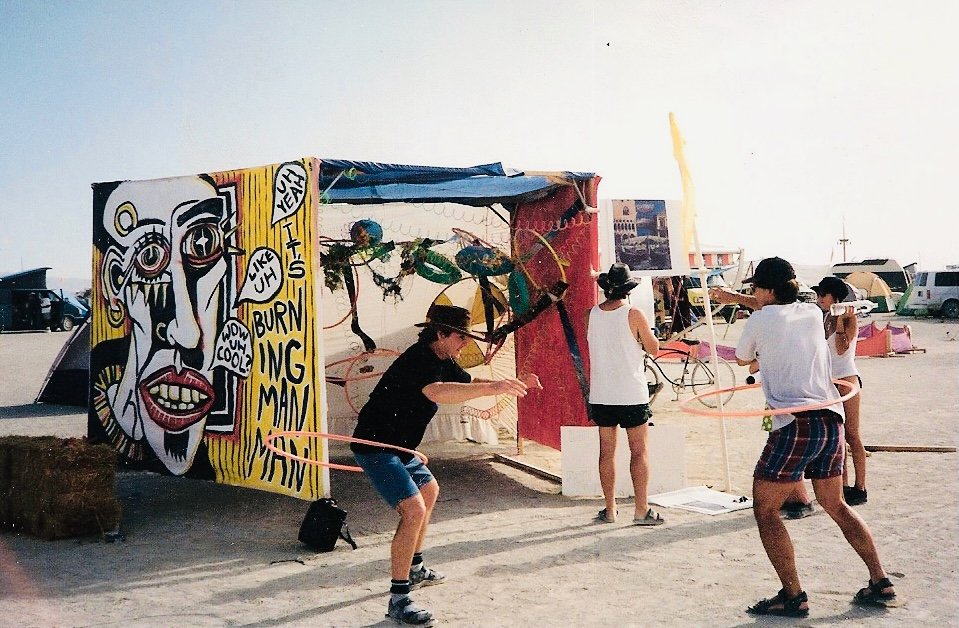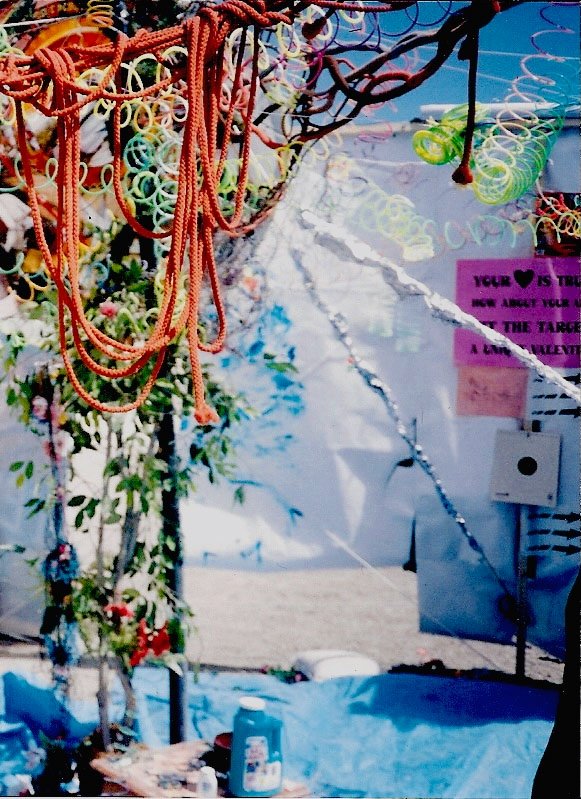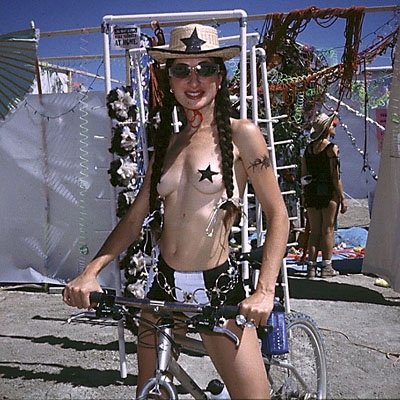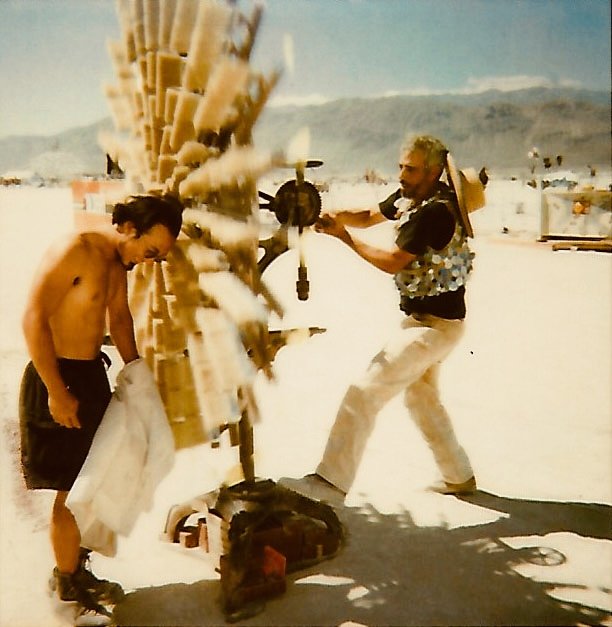Burning Man Projects - 1996 to 2002
Suddenly the 50 people at Committee for Public safety events became 4000, except that they did not live in Las Vegas. At Burning Man in 1995, principles that guided the CPS were being practiced on a grand scale by people who had been at it much longer than us. Black Rock Desert was 500 miles from Las Vegas but still inside Nevada. Technically it was in our backyard, if we were willing to consider the novel idea that people who lived in Las Vegas also live in Nevada.
The Black Rock Desert was empty in a way few of us had experienced elsewhere. An unearthly far wide horizon distorted perspective. Large and small were interchangeable. The alien nature of the place called for a response that addressed its difference. A culture was in development, not yet defined. Students of art history know that this is among the rarest of events that artists may discover. It was a challenge to produce art unlike what we had made elsewhere.
1996
Hula Hoop Training Center
Monk travel magazine had a unique new production model, the magazine constructed as digital files while Michael Lane and Jim Crotty travelled in a van from coast to coast. The Monks coordinated my providing the interior of a structure with a mural painted on its exterior by a New York artist. The two of us did not bother to discuss our plans. Asked to contribute to an unknown culture, the New Yorker instinctively chose snark. A hula hoop training center may have been just what the New Yorker dreaded and hoped he would find in California. It was a cute meet. (We note that there was never a time so early in Burning Man’s history when people did not make fun of it.)
The Training Center encouraged people to practice hula twirling without worrying about the shame hula students feel if their hoop falls down. My trainer hula hoops were held in the air by springs. I awarded twenty or thirty hoops to class graduates. People too shy to practice hooping were still welcome to a free poster, just for thinking about it. The hoops were leftover stage elements from the Committee for Public Safety.


1997
Gambol, and The Human Carwash 01
Everything I had done previously related to images. It was meant to be seen. As far as I had got away from the principle was to build stage sets that might envelope a small audience. Staging could make an audience part of the event. In the undefined culture of Black Rock City I would make work in which visual appeal was of of incidental interest. Everything about appearance was secondary to how it might feel in a different way than through the eye. There was no way to study the topic except through practice: Try something and see what worked.
Gambol was a grab-bag of experiments with physical engagement as a necessary element within a piece of art. Most intriguing was the response generated by a freestanding portal set outside the primary structure. I used feather dusters to line the gate. The wide topic of studying physical interactivity resolved itself into a narrower focus on tactile immersion. The florescent plastic Slinkys were leftovers from quick stage sets designed for the Committee for Public Safety.
Our Las Vegas crew joined Illumination Village, an alliance of Burning Man art makers mostly focused on producing controlled fire art. The Esplanade was developing that would be the primary pedestrian artery through the event. Illumination Village would be placed on the Esplanade for many years, an ideal location for presenting art designed for many people at once to interact with it.







1998
The Human Car Wash 02
Art based on tactile immersion would never function outside the developing culture of Burning Man. Whether it was a prank or a sincere gesture was unclear. It had no commercial potential. It was a perfect topic for playa projects. Last year's quick experiment became a 40-foot-long exploration of tactile drama. Within a procession of contrasting types of tactile elements there was a rising and falling arc of suspense and release.
During the short while I was in formal art school, Conceptualism and Minimalism were popular. I was not entranced by the theories but I did feel respect for them. The aesthetic drama of the Human Car Wash was in the physical sensation of walking through it. Traditional art rhetoric describing appearance was insufficient for describing the drama in a wholly tactile experience. I felt like I was tipping my hat to my old Conceptualist profs who thought I was not paying attention.




1999
The Human Car Wash 03
A regular temptation for Burning Man project builders is to dream for a moment that our work might match the breadth of the playa. We only need to build bigger projects or more of them. This was the year when I presented three projects. Last year’s 40-foot-long Human Car Wash now was 80-feet-long.













1999
The Self-Propelled Pussy Fan
The Pussy Fan was the beginning of my experiments with amplified motion. A bit of work by a visitor could produce a visual amplification of the effort that might be seen from far away. It was another way of playing with the scale of the playa.
Erowid Psychoactive Vaults, an estimable online site for information about recreational drug use, featured the Self-Propelled Pussy Fan as an example of the perplexing art sometimes found in Black Rock City. I took this as a great compliment.



1999
The Micro-Rave
16 battery operated toy pianos played at such low volume that they could not be heard outside the piano grid. But within it, 16 people could hear one another play the tiny pianos. The low volume made the grid a contrasting morning stop for people on the way home from the 100,000 watt speakers at the average Burning Man rave.


2002
Tactile Compass 01
A drive on an Arizona side highway turned up a junkyard with a Civil War-era hand-cranked drill press. I converted it into a kind of ship's wheel holding a plate on which were mounted 140 feather dusters. The person turning the wheel could not see the person enjoying the feather dusters. It was a sure conversation starter. But my previous experiments with feather dusters left masses of single feathers littering the playa. Henceforth, feather dusters were banned from Burning Man, as well they should have been. As a result, the Tactile Compass used 140 soft paint brushes instead of feathers. It was a fair substitution.
The reconfiguration of the old drill press set different gears that were mighty rusty rolling over each other. The 100-year-old teeth on the gears disintegrated from the use they got. It was the sort of lesson that could only be learnt from practice. It was a flaw that could be corrected but not this year.



